Pat Bertram's Blog, page 12
October 23, 2022
I’m Doing Well
If you’re one of those who has been worried about my virtual disappearance, worry no more. I’m doing well. I haven’t disappeared in real life, just online life. I still manage to blog once or twice a week, but I don’t go through the rigmarole of posting the link on Facebook. It got to be too much, not just writing every day, but reblogging to another blog as well as posting the photo on a third blog and reblogging that to the reblogged blog just so I can bypass FB’s unfairly punitive ways to post my blog link on the site.
I feel good about not blogging every day, and I feel even better about boycotting FB, though I do feel bad about not keeping up with grief friends, both online and off. I just can’t handle secondhand grief anymore. (A friend recently died, and I dread seeing her husband, also a friend, when he returns to this country. It’s not exactly kind or generous or sensitive, but it’s the truth of me right now.)
I’ve also been doing well with my yard — the leaves from my neighbors’ trees will start falling any day (perhaps even later today because of the high winds we’re dealing with), but until it’s time to rake those leaves or to water the grass again, there’s nothing for me to do outside. What a change! Admittedly, I earned the change. I’ve been spending three or four hours every day digging up Bermuda grass, weeds, and dead annuals in preparation for winter wildflower sowing. I also spent several of those days digging up, hacking apart, and replanting the New England aster. If even half of them survive the winter, I’ll be having to deal with maybe a hundred plants next fall. But that’s not for another year.
I’ve also been doing well with cleaning house — everything is as spotless as I can get it, so there’s no inside chore niggling at me, either.
So, with nothing to do today except read and relax and fix a couple of meals, I’m doing really well!
And speaking of “well,” Here’s a well of a different sort. It’s funny, but I wished for a wishing well, and look! I got my wish! I had to fix the roof that was falling apart, and I shingled it with leftover shingles, and now — oh, what a beauty!
I threw wishes into the well for your wellbeing, so I hope it works and that you’re doing well, too.
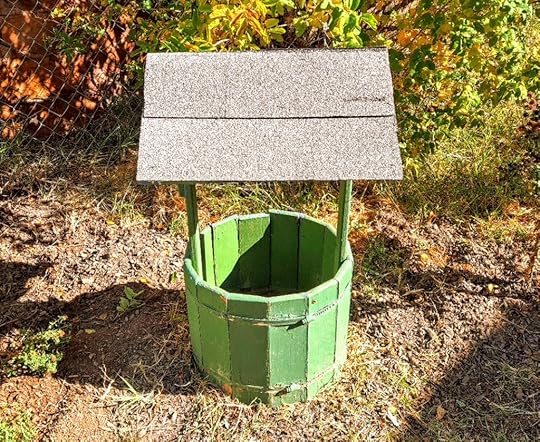
***

Pat Bertram is the author of Grief: The Inside Story – A Guide to Surviving the Loss of a Loved One. “Grief: The Inside Story is perfect and that is not hyperbole! It is exactly what folk who are grieving need to read.” –Leesa Healy, RN, GDAS GDAT, Emotional/Mental Health Therapist & Educator.
October 16, 2022
Midnight Drama
In the light of day, the goings on of last night seem rather silly and insignificant, but in the dark, after being jerked out of a deep sleep, it was drama enough — and trauma enough — for me. What makes it so much worse, is that it’s my own fault.
I’ve been trying to keep to a schedule to change the batteries in my smoke alarms every year, but this year, I let the date pass, though I thought about doing the job every day, and even wrote a note reminding myself to change the batteries in the smoke alarms, but still I procrastinated. It’s a difficult task for me — getting out the ladder, climbing a few rungs, and then trying to get to the old batteries to change them. It’s also ridiculous because there are so many smoke alarms in this very small house. One in each bedroom, one outside the kitchen, one in the hallway, as per code, but that makes four smoke alarms within just a few feet of each other. A fifth smoke alarm is on the ceiling of the enclosed porch. That’s a lot of ladder climbing for an older woman with bum knees!
So last night, I wasn’t surprised — just adrenaline-rush startled — to be awakened by an insanely loud metallic chirp. I lay there for a minute hoping somehow I’d dreamed the noise, but nope. There it was again. A brief screech from the smoke alarm in my bedroom.
Not wanting to go out to the detached garage to get the six-foot ladder, I got my stepstool and climbed on to the top rung, thinking all the while how idiotic that was. I mean, there I was, half asleep, heart pounding, and rather past my prime for such shenanigans. Still, I managed to change the batteries. Unfortunately, that didn’t stop the intermittent screech. I closed the bedroom door, put in earplugs, and went to sleep on my daybed, but I was too adrenalized to be able to fall asleep. Besides, muted as it was, I was still aware of the chirp.
Knowing I wouldn’t sleep (and knowing I desperately needed to sleep off a cold that was inching its way into my system), I got out of bed and went online to see what the problem could be. Apparently, after taking out the batteries and before putting in the new ones, I was supposed to push the “test” button for fifteen seconds to clear the charge.
Sighing to myself, I went outside, unlocked the garage, got the ladder (I wasn’t about to try balancing again on the top rung of the stepstool), got a second set of new batteries (just in case I’d put the old ones back in the alarm), and then followed directions. And the thing still chirped.
But just once. Whew!
As I said, the midnight drama (actually it was closer to 1:30 if I want to be accurate) doesn’t seem that bad now, but it sure was a problem last night. Obviously, it was less of a problem than it would have been if the alarm had sounded because of a fire (for which I am grateful), but it certainly wasn’t fun, that’s for sure.
Now I’m off to change the other batteries, though I really don’t want to.
Hmmm. Perhaps I could put it off for another day or two . . .

***

Pat Bertram is the author of Grief: The Inside Story – A Guide to Surviving the Loss of a Loved One. “Grief: The Inside Story is perfect and that is not hyperbole! It is exactly what folk who are grieving need to read.” –Leesa Healy, RN, GDAS GDAT, Emotional/Mental Health Therapist & Educator.
October 11, 2022
Filling My Life
I can see why I had such a hard time trying to find topics when I was blogging every day — there are no great emotions in my life as when I was dealing with grief, no great adventures as when I was hiking or road tripping, no wonderful new experiences as when I bought my house. There’s just me going about what has become my normal life, which mostly entails spending two or three hours working on my yard and the rest of the time reading or relaxing and trying to recuperate from the labor.
To be honest, I’m not sure this is a fulfilling life, but to be even more honest, I’m not sure I care. It takes a lot of energy to search for ways of being fulfilled and then to follow through, and I have never been a high-energy person. I do have a part-time job looking after an older woman, so that’s something anyone would consider worthwhile. Outside of that job, however, my only responsibility is looking after myself, and that should be at least as worthwhile as looking after someone else, right? I’m not sure why, but we seldom think we are as important as others. When we’re coupled, it’s easy to feel as if we’re leading a worthwhile and fulfilling life because of its “we” centeredness. Being “me” centered is considered selfish, but when “me” is all there is, then by definition, we have to give ourselves as much validity as when we were a “we.”
Now that I think of it, I spend more time looking after my yard than I spend looking after myself. I’m pretty easy to care for — make sure I have plenty of books, fix relatively healthy meals, try to put myself to bed at a reasonable hour. My yard, on the other hand, is rather demanding. Because of the lack of natural moisture in the area (due to a curse put on this land by the survivors of the Sand Creek massacre, I’ve been told, and even a subsequent blessing ceremony by more current members of that tribe couldn’t remove the curse) I have to spend time watering my grass and plants. I gave up weeding my gardens in the summer because it was impossible to keep on top of the growth (the weeds around here thrive even without much moisture), so I am having to do now what I didn’t do then. I’m also extending my garden, bit by bit. (There is still a swath of my backyard that has never been cleared; the weeds and weedy grasses are so dense it takes an hour just to clear a few feet.)
Although such work might not be compelling to others, it is to me, especially this time of year when the cleared gardens stay cleared, and the fall flowers bring intense color to the yard. It’s also fulfilling work in a creative sort of way, with the yard as a canvas I paint with plants. Although the heat-stressed grass hasn’t yet greened up, at least, with the cooler temperatures, I don’t have to worry about additional damage the sun can do, and there’s always hope for the spring.
Actually, hope isn’t just for spring. When there aren’t big emotions, big adventures, big experiences to fill my life, there’s always hope for something — a chance visit with a friend, a few words that make me think, a new flower to plant or to enjoy, a book that keeps me interested. Even without hope of . . . something . . . there’s still today and my gratitude that even though there might not be a lot to bring drama to my life or heighten my emotions (and hence give me blog topics), there’s nothing to torment me, either.
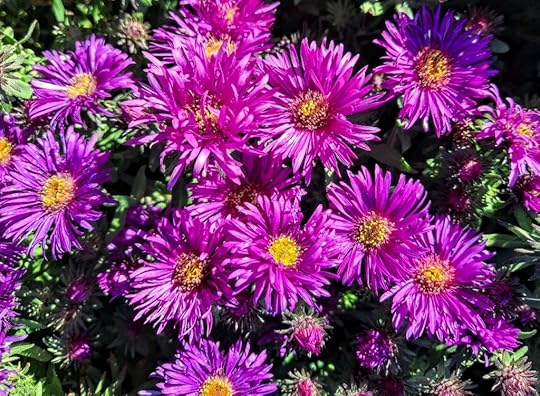
***

Pat Bertram is the author of Grief: The Inside Story – A Guide to Surviving the Loss of a Loved One. “Grief: The Inside Story is perfect and that is not hyperbole! It is exactly what folk who are grieving need to read.” –Leesa Healy, RN, GDAS GDAT, Emotional/Mental Health Therapist & Educator.
October 7, 2022
Things That Fall from the Sky
Yesterday was a perfect fall day. Today, not so much. In fact, this cold and dreary day feels like a harbinger of winter, and I am so not ready. Luckily, it will warm up a bit the next few days, and with this chill reminder that autumn around here is a relatively short season (at least weather-wise; technically, it’s the same length as any other season), I will make an even greater point of enjoying the coming warmth.
The long-range forecast is for a warmer than usual October and November, but I have lost all belief in current forecasting ability. Not that I had much faith in forecasters to begin with, but at least they used to give a hint of what the day’s weather would be. Now, despite all their advanced tools, the meteorologists seem to get it wrong more often than seems . . . seemly. Of course, that’s probably just the prejudice of hindsight, with me remembering the days when they said it would rain and instead the sun came out but not the days they got it right.
[I had to look up the word “meteorologist” because suddenly it looked wrong, as if it should be a study of meteors rather than weather, but yes, that’s the right spelling. The word comes from Meteorologica, a book about weather and climate change written by Aristotle in 340 BC. He gave the book that name because it dealt with things that fall from the sky, like meteors. And because weather forecasters also deal with things that fall from the sky such as snow and rain and sunshine, they have become known as meteorologists.]
If the professionals have no idea what the long-range forecast will be (and even if they do know), then obviously, all I can do is what I always do — deal with whatever each day brings. And today brought such a chill that I wimped out and turned on the heat.
Luckily, the autumn flowers don’t seem to mind the cold; they are as bright and cheerful as they were yesterday.
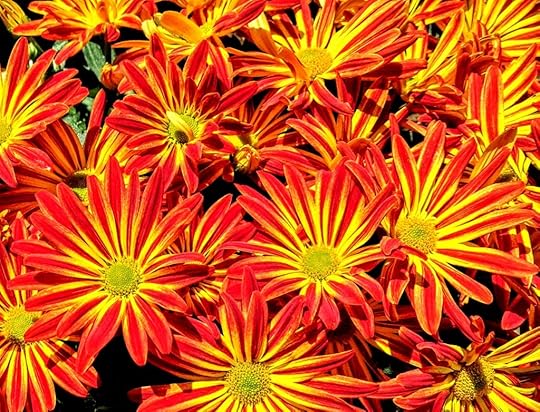
***

Pat Bertram is the author of Grief: The Inside Story – A Guide to Surviving the Loss of a Loved One. “Grief: The Inside Story is perfect and that is not hyperbole! It is exactly what folk who are grieving need to read.” –Leesa Healy, RN, GDAS GDAT, Emotional/Mental Health Therapist & Educator.
October 6, 2022
Autumn Gardening
I’ve spent a lot of time working out in my yard this year, two or three hours most days, and to my surprise, I’ve discovered that the past couple of weeks, ever since autumn arrived, have been the most enjoyable. The weather has been nice — still and warm, without the strong winds of spring or the scorching temperatures of summer. But more than that, whatever work I have done stays done. In the summer, when I weeded, that wasn’t the end. More weeds came, and the weedy grasses came back with a vengeance. (Admittedly, “vengeance” is a human reaction, not a plant one, but the way those grasses grew it seemed vengeful.) But this fall? Whatever flower bed I cleared out stayed cleared out, and I can actually see an end to these tasks for the year. At the same time, I feel as if I am preparing the soil for new hopes and dreams to flower next year.
Even better, with the weeds and undergrowth cleared out, the bare spots in my garden are obvious, so I know where to plant new flowers. Of course, come spring, those bare spots could fill up with self-planted flowers since I let so many of them go to seed, but for now, I feel as if I have a bit of control. In the summer, the weeds, the sun, and the aggressive plants are in control, but for now, life is taunting me by letting me feel as if I am in charge. Still, whoever or whatever is in charge, it feels good to stroll around my property or sit on a bench and see all that has been accomplished.
Best of all, the autumn flowers are gorgeous, giving my yard a park-like appearance.
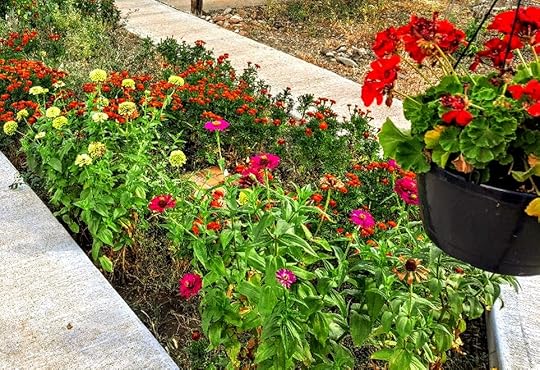
***

Pat Bertram is the author of Grief: The Inside Story – A Guide to Surviving the Loss of a Loved One. “Grief: The Inside Story is perfect and that is not hyperbole! It is exactly what folk who are grieving need to read.” –Leesa Healy, RN, GDAS GDAT, Emotional/Mental Health Therapist & Educator.
October 2, 2022
A Spring in My Step
My step has lost its bounce, as if the balls of my feet have become underinflated. At best, I tend to plod; at worst, I lumber. Of course, a lot of this has to do with tiring myself — and especially my legs — working in the yard, but there is so much to do out there before winter that I tend to work more than I should. Still, I thought I’d check online to see what — if anything — would help put the spring back in my step.
I had to laugh. The first few articles I found had advice like think positively, eat right, drink right, work in a garden, go shopping, visit with friends, have some fun. Good advice, but not exactly what I was looking for. I did eventually find some exercises to help improve strength and balance in the lower body and enable elderly people to walk better and be safer.
After more research, I came across an interesting explanation of why older people lose the spring in their step: a difference in joint and muscle redistribution. For younger people, a normal gait is powered 1/3 by the hips, 1/3 by the knees, and 1/3 by the ankles. For elderly folks, the gait distribution is 3/4 by the hips, 1/8 by the knees and 1/8 by the ankles.
Because of this, you’d think that ankle and knee strengthening exercise would help redistribute the propulsion ratios, but although those exercises are valuable and help with many problems, exercise itself does little to put the spring back in a person’s walking gait. I can attest to that — I am doing various ankle/hip/knee exercises, and although they are helping my knees, they aren’t doing much to help with the spring in my step.
What does help? Paying attention to your gait when walking, standing tall as if peeping over a crowd, and actively engaging the ankles — land on the heel, roll the foot to the ball of the foot and push off.
Of course, as with everything I research, there is controversy. Some physical therapists and exercise trainers say this is entirely the wrong way to walk, and each offers their advice to walk correctly, such as landing on the outside of the heel and slightly move it inward to land flat. Or don’t land on the heel at all but walk toe to heel. Or land on the ball of the foot and use your hips to propel you forward because your hips are the bigger muscles and hence have more power. (I wonder if this is why elderly use their hips more than ankles or knees — since it is the biggest muscle group, it would retain muscle mass longer than other muscles.)
To me, the correct way of walking is whatever is most comfortable, least painful, and lightest on the feet, so I suppose almost all ways of walking are correct for someone.
There’s not much I can do about trying to propel myself forward when I’ve spent myself — I’m lucky to be able to move at all at those times — but I have noticed the rest of the time that if I pay attention and actively engage my ankles, I do seem to have more of a spring in my step.

***

Pat Bertram is the author of Grief: The Inside Story – A Guide to Surviving the Loss of a Loved One. “Grief: The Inside Story is perfect and that is not hyperbole! It is exactly what folk who are grieving need to read.” –Leesa Healy, RN, GDAS GDAT, Emotional/Mental Health Therapist & Educator.
September 25, 2022
Gorgeous Autumn Day
I’ll bet you can’t guess what I did today! Aww, you guessed it. Where else would I be on such on gorgeous autumn day but out working in my yard? Of course, if you guessed blogging or being on the internet, that would have been a sure bet, too, because here I am. Or if you guessed reading, that too would have been a win because that’s how I will spend the rest of the day.
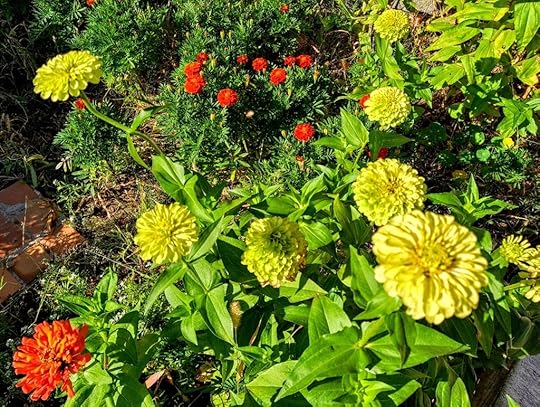
Hmm. Sounds as if I live too narrow a life. I might have to do something about that eventually to keep from the dreaded stagnation (dreaded by me, that is), but for now, there’s a lot of work to do, not just the usual maintenance, such as watering and mowing the grass and digging weeds, but also getting ready for late fall planting (lilies and wildflowers) and preparing for winter.
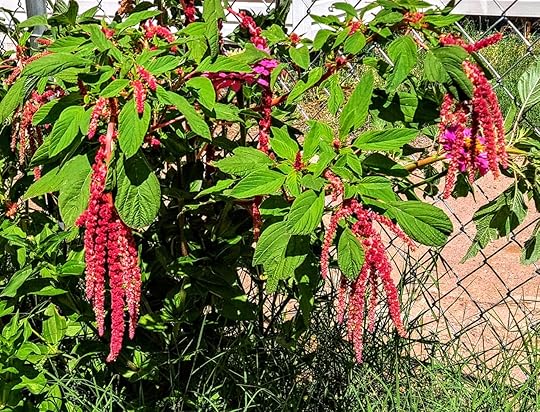
It seems as if summer was never-ending, but then, in just a snap of the fingers, it was over. I know it was a long, hot four months, but in retrospect, the whole summer was truncated. Except for the work I did, though, there wasn’t much to distinguish the days from one another. There seemed to be few summer flowers, and those that did come up, like the lilies and day lilies were swamped in wildflowers or weeds. Now, though, there is plenty of color! Zinnias. Amaranth. Chrysanthemums. New England Asters. Marigolds.
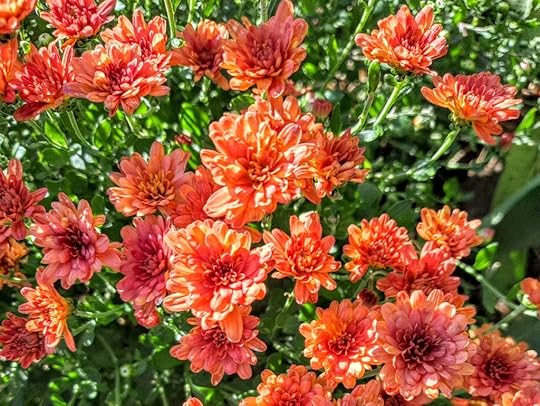
In another snap of the fingers, winter will be here, but I’m not going to think of that — I’ll just enjoy the lovely fall weather as long as it lasts. (Warm days, cool nights — what’s not to like?)
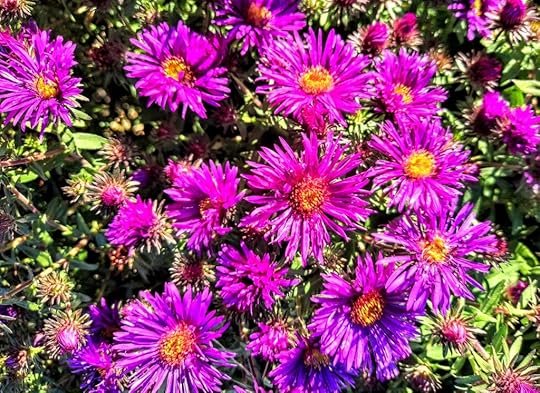
I wasn’t sure whether I should use the term “autumn” or “fall” for this post. I recently came across one of those USA-bashing comments intimating that the sophisticated British use the term autumn but the uncouth and simple Americans use “fall” (named because of the falling leaves). I certainly didn’t want to bring ridicule down on my head for using the wrong word, so I looked up the origin of both terms. It turns out that “fall” is not something you can lay at our American feet. Both words originated in Britain. Autumn was first used in the 1300s. Fall was first used in the 1500s. But the correct term for this season is (or at least it was before 1300) “harvest.”
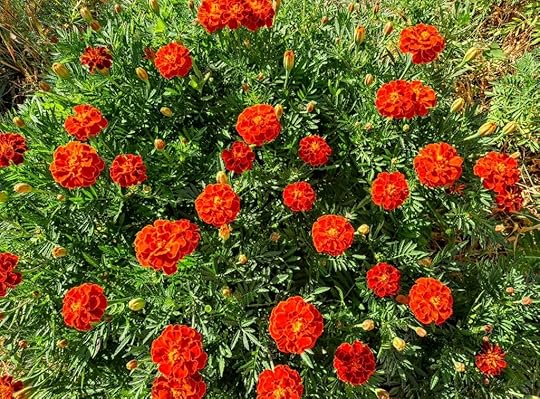
Still, whatever the name for this season — fall or autumn or harvest — it certainly has been a pleasant and colorful (and exhausting) one for me.
***

Pat Bertram is the author of Grief: The Inside Story – A Guide to Surviving the Loss of a Loved One. “Grief: The Inside Story is perfect and that is not hyperbole! It is exactly what folk who are grieving need to read.” –Leesa Healy, RN, GDAS GDAT, Emotional/Mental Health Therapist & Educator.
September 20, 2022
A Burden I Didn’t Know I Was Carrying
A few days ago, I wrote about rethinking this whole blogging thing. Since I had nothing else to write about, I’d been writing about the one thing I know — me — and I’d come to the conclusion it wasn’t healthy or smart to put so much of myself out there.
I thought it would be difficult to break the daily blogging habit of almost three years, but in the end, it was simple. I did what I felt like doing, which was keep my thoughts to myself. Actually, it wasn’t that I wanted to keep my thoughts to myself, but that I didn’t want to have any thoughts in the first place. It’s hard, of course, not to think, but it’s one thing to let one’s thoughts slide into the mind and then slide right out again, and another thing to try to sift through all those fleeting thoughts, capture one, and then expand on it for a blog topic.
What a relief to just let the thoughts go.
And I was right — the world did not come to an end when I stopped blogging every day.
What I found interesting is how this new non-daily blog habit has made itself felt. It gives me two or three extra hours every day. I imagine my breezy writing style makes it seem as if I jot a few words and then simply publish what I write, but it takes a lot of work to make something seem light and easy — writing, editing, re-editing, re-re-editing, adding tags to the blog so it will show up in search results, preparing a photo, publishing the blog, republishing to another blog, posting the reblogged link on Facebook. Even better, because I’m not blogging, I have no need to check Facebook and the blogsite and my email because there are no comments to respond to. So yes, a lot of free time!
Without having to think about what I am thinking, and without having to examine my days for a topic, I have a lot of free mental time, too. And I know that Socrates is wrong: the unexamined life is worth living. In fact, it might even be worth more than an examined life.
And then there’s the whole compassion fatigue situation. Because I am not a therapist or a grief counselor, I never would have thought such a state would apply to me, but over the past twelve and a half years I have mentored (for lack of a better word) hundreds of people through the worst of their grief, and I am truly fatigued. I have always felt powerless in the face of other people’s grief, but knowing at least to an extent what they are going through, I tried my best to listen and be kind, but now I am having a hard time summoning up any compassion or patience. I understand that to them, grief is new and ever-present, but to me . . . not so much. My life with Jeff is now far in the past and so is my grief for him. In fact, I barely remember what I went through unless I am reminded by people who want to talk about their grief. So, without having to deal with other people’s grief, I have a lot of free emotional time, too.
I don’t regret my work on behalf of grievers, in fact, I’m glad I could help, but now it’s time for me to let that part of my life go. So for those of you who need help with your grief or who simply want to talk about what you are going through, please check out the various grief forums and online grief support groups. I know a lot of people who found them helpful and comforting, and I am sure you will, too.
So, what am I doing with all this free time? Not thinking, that’s for sure. Not feeling much, either, except lightness at having shrugged off a burden I didn’t know I was carrying.

***

Pat Bertram is the author of Grief: The Inside Story – A Guide to Surviving the Loss of a Loved One. “Grief: The Inside Story is perfect and that is not hyperbole! It is exactly what folk who are grieving need to read.” –Leesa Healy, RN, GDAS GDAT, Emotional/Mental Health Therapist & Educator.
September 16, 2022
Daily Blogging
I’m starting to rethink this whole blogging thing, especially daily blogging, and that’s not a bad thing. Next week will be the fifteenth anniversary of when I started this blog. I’d read how important blogging was for authors, both as a way of getting known and as a way of connecting with readers, so even though I had no idea what a blog was, wasn’t yet published, had nothing to say, I jumped right in. I didn’t blog every day at the beginning, though during the years, I had several stretches where I did blog every day. Out of the 5,480 days from the beginning until today, I’ve blogged 3,565 times.
I started out writing about writing and books, then after Jeff died, I let my grief spill over onto this blog. When I set out on my 12,500 mile, 5-month cross-country trip, the focus of my blog changed again. And then it changed again when I became a houseowner with a yard to landscape.
Now? I’m still involved with gardening, but I don’t want to turn this into a gardening blog. Nor am I especially interesting in continuing to chronicle my daily life, my ups and downs, my moods, my periodic loneliness, and my infrequent bouts of missing Jeff. I don’t think it’s healthy or smart to put so much of myself out there. It was one thing when I was frantic with grief and needed an outlet, but I certainly don’t need an outlet when I am merely feeling melancholy or even just blah. Nor do I want to put emphasis on such times by writing about them.
Even worse than writing about those moods is trying to put a good slant on them. Sometimes it’s important to just be. Don’t name what the feeling is. Don’t write about it. Don’t think about it. Don’t try to be grateful or see the bright side. Just be.
I’ll probably continue daily blogging for a while longer because it’s the only writing I do, and it is a good discipline, but to be honest, it would be just as good a discipline if I forgot blogging and started a new book. (Not that I have any plans to write another book, I’m just giving an example.)
Also, after my current streak of 1,089 days of daily blogging, not blogging every day is too big a decision to make lightly. Or maybe it isn’t a big decision — all I’d have to do is skip a few days and see what happens.
The world wouldn’t come to an end, that I know.

***

Pat Bertram is the author of Grief: The Inside Story – A Guide to Surviving the Loss of a Loved One. “Grief: The Inside Story is perfect and that is not hyperbole! It is exactly what folk who are grieving need to read.” –Leesa Healy, RN, GDAS GDAT, Emotional/Mental Health Therapist & Educator.
September 15, 2022
Uneasy
I wasn’t sure I wanted to post a blog today — I’m feeling uneasy and didn’t really want talk about it lest it seem as if I were complaining, though that wouldn’t have been my intention. Then I decided that this disinclination to “share” anything today wasn’t worth breaking a 1,087 daily blog streak, and anyway, I’ve often spoken of things that didn’t exactly show me in a good light.
(“Share” is in quotation marks because I have come to hate that word — it’s such a social networking cliché, but it’s the only one I’ve found that works in this particular context.)
To be honest, this uneasiness is not that big of a deal — I’m just feeling out of sorts and didn’t want to seem self-indulgent by writing about it. Since I couldn’t think of another topic that I haven’t done to death (I mean really, how many times can I write about grass?), and since I didn’t want to use such a feeble excuse as uneasiness to quit the daily blog routine, and since I’ve confessed to worse things, here I am.
Yesterday I went to a meeting of a guild I belong to, and maybe three times as many people showed up compared to what I’m used to. I was fine while I was there, but when I got home, I felt . . . not sad exactly, but definitely not happy. Just uneasy. I have never done well in groups, and this was the biggest group I’ve been in for more than two years, and apparently, it was more than I could handle.
I woke this morning in that same uneasy state, but since I didn’t have to work today, I went outside to continue digging up weedy grass. (Oops. I there is that “G” word, after all.) I had nothing else to do, and I figured the physical activity would help get me back to my normal stoic self. It didn’t. In fact, it made me wonder what the heck I’m doing all that work for. It seems silly, really — all that work and worry just for a bit of a lawn and a few flowers. But then I reminded myself I need a focus. It doesn’t matter how silly the focus is — it’s important to have something to concentrate on outside of myself to keep me from looking too deeply into myself or looking too closely at my life.
I’m okay living alone (and considering my reaction to yesterday’s meeting, I’m apparently more okay being alone than being around a lot of people), but if I look at the realities — growing old alone, having no one to do nothing with, having to rely so much on myself — it just seems too dang sad. So I try to focus on other things, no matter how silly they might seem. Like working in the yard.
This uneasiness will pass as moods generally do. If not, well, I’ll be back at my care-giving job tomorrow, and that for sure will make me think of something — or rather someone — besides myself.

***

Pat Bertram is the author of Grief: The Inside Story – A Guide to Surviving the Loss of a Loved One. “Grief: The Inside Story is perfect and that is not hyperbole! It is exactly what folk who are grieving need to read.” –Leesa Healy, RN, GDAS GDAT, Emotional/Mental Health Therapist & Educator.



